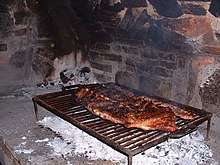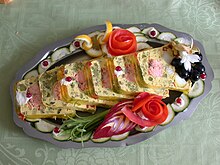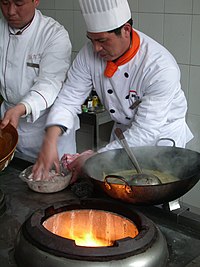Bitter
Bitterness is a sensation often considered unpleasant characterized by having a sharp, pungent taste. Dark, unsweetened chocolate, caffeine, lemon rind, and some types of fruit are known to be bitter.Umami
Umami, the Japanese word for delicious, is the least known in Western popular culture, but has a long tradition in Asian cuisine. Umami is the taste of glutamates, especially monosodium glutamate or MSG.[15] It is characterized as savory, meaty, and rich in flavor. Salmon and mushrooms are foods high in umami. Meat and other animal byproducts are described as having this taste.Cuisine
Many cultures have a recognizable cuisine, a specific set of cooking traditions using various spices or a combination of flavors unique to that culture, which evolves over time. Other differences include preferences (hot or cold, spicy, etc.) and practices, the study of which is known as gastronomy. Many cultures have diversified their foods by means of preparation, cooking methods, and manufacturing. This also includes a complex food trade which helps the cultures to economically survive by way of food, not just by consumption. Some popular types of ethnic foods include Italian, French, Japanese, Chinese, American, Cajun, Thai, and Indian cuisine. Various cultures throughout the world study the dietary analysis of food habits. While evolutionarily speaking, as opposed to culturally, humans are omnivores, religion and social constructs such as morality, activism, or environmentalism will often affect which foods they will consume. Food is eaten and typically enjoyed through the sense of taste, the perception of flavor from eating and drinking. Certain tastes are more enjoyable than others, for evolutionary purposes.Presentation
Main article: Food presentation
Aesthetically pleasing and eye-appealing food presentations can
encourage people to consume foods. A common saying is that people "eat
with their eyes". Food presented in a clean and appetizing way will
encourage a good flavor, even if unsatisfactory.[19][20]Contrast in texture
Texture plays a crucial role in the enjoyment of eating foods. Contrasts in textures, such as something crunchy in an otherwise smooth dish, may increase the appeal of eating it. Common examples include adding granola to yogurt, adding croutons to a salad or soup, and toasting bread to enhance its crunchiness for a smooth topping, such as jam or butter.[21]Contrast in taste
Another universal phenomenon regarding food is the appeal of contrast in taste and presentation. Opposite flavors, such as sweet and saltiness, tend to go well together, such as in kettle corn and with nuts.Food preparation
Main article: Outline of food preparation
While many foods can be eaten raw, many also undergo some form of preparation for reasons of safety, palatability, texture, or flavor.
At the simplest level this may involve washing, cutting, trimming, or
adding other foods or ingredients, such as spices. It may also involve
mixing, heating or cooling, pressure cooking, fermentation, or combination with other food. In a home, most food preparation takes place in a kitchen. Some preparation is done to enhance the taste or aesthetic appeal; other preparation may help to preserve the food; others may be involved in cultural identity. A meal is made up of food which is prepared to be eaten at a specific time and place.[22]Animal preparation
The preparation of animal-based food usually involves slaughter, evisceration, hanging, portioning, and rendering. In developed countries, this is usually done outside the home in slaughterhouses, which are used to process animals en masse for meat production. Many countries regulate their slaughterhouses by law. For example, the United States has established the Humane Slaughter Act of 1958, which requires that an animal be stunned before killing. This act, like those in many countries, exempts slaughter in accordance to religious law, such as kosher, shechita, and dhabiĥa halal. Strict interpretations of kashrut require the animal to be fully aware when its carotid artery is cut.[23]On the local level, a butcher may commonly break down larger animal meat into smaller manageable cuts, and pre-wrap them for commercial sale or wrap them to order in butcher paper. In addition, fish and seafood may be fabricated into smaller cuts by a fish monger. However fish butchery may be done on board a fishing vessel and quick-frozen for preservation of quality.[24]
Cooking
Main article: Cooking
The term "cooking" encompasses a vast range of methods, tools, and
combinations of ingredients to improve the flavor or digestibility of
food. Cooking technique, known as culinary art,
generally requires the selection, measurement, and combining of
ingredients in an ordered procedure in an effort to achieve the desired
result. Constraints on success include the variability of ingredients,
ambient conditions, tools, and the skill of the individual cook.[25]
The diversity of cooking worldwide is a reflection of the myriad
nutritional, aesthetic, agricultural, economic, cultural, and religious
considerations that affect it.[26]Cooking requires applying heat to a food which usually, though not always, chemically changes the molecules, thus changing its flavor, texture, appearance, and nutritional properties.[27] Cooking certain proteins, such as egg whites, meats, and fish, denatures the protein, causing it to firm. There is archaeological evidence of roasted foodstuffs at Homo erectus campsites dating from 420,000 years ago.[28] Boiling as a means of cooking requires a container, and has been practiced at least since the 10th millennium BC with the introduction of pottery.[29]
Cooking equipment

A traditional asado (barbecue)
Main article: Cookware and bakeware
There are many different types of equipment used for cooking.Ovens are mostly hollow devices that get very hot (up to 500 °F) and are used for baking or roasting and offer a dry-heat cooking method. Different cuisines will use different types of ovens; for example, Indian culture uses a Tandoor oven, which is a cylindrical clay oven which operates at a single high temperature.[30] Western kitchens use variable temperature convection ovens, conventional ovens, toaster ovens, or non-radiant heat ovens like the microwave oven. Classic Italian cuisine includes the use of a brick oven containing burning wood. Ovens may be wood-fired, coal-fired, gas, electric, or oil-fired.[31]
Various types of cook-tops are used as well. They carry the same variations of fuel types as the ovens mentioned above. Cook-tops are used to heat vessels placed on top of the heat source, such as a sauté pan, sauce pot, frying pan, or pressure cooker. These pieces of equipment can use either a moist or dry cooking method and include methods such as steaming, simmering, boiling, and poaching for moist methods, while the dry methods include sautéing, pan frying, and deep-frying.[32]
In addition, many cultures use grills for cooking. A grill operates with a radiant heat source from below, usually covered with a metal grid and sometimes a cover. An open pit barbecue in the American south is one example along with the American style outdoor grill fueled by wood, liquid propane, or charcoal along with soaked wood chips for smoking.[33] A Mexican style of barbecue is called barbacoa, which involves the cooking of meats such as whole sheep over an open fire. In Argentina, an asado (Spanish for "grilled") is prepared on a grill held over an open pit or fire made upon the ground, on which a whole animal or smaller cuts are grilled.[34]
Raw food preparation
Main article: Raw foodism
Certain cultures highlight animal and vegetable foods in their raw state. Salads consisting of raw vegetables or fruits are common in many cuisines. Sashimi in Japanese cuisine consists of raw sliced fish or other meat, and sushi often incorporates raw fish or seafood. Steak tartare and salmon tartare are dishes made from diced or ground raw beef or salmon, mixed with various ingredients and served with baguettes, brioche, or frites.[35] In Italy, carpaccio is a dish of very thinly sliced raw beef, drizzled with a vinaigrette made with olive oil.[36] The health food movement known as raw foodism promotes a mostly vegan
diet of raw fruits, vegetables, and grains prepared in various ways,
including juicing, food dehydration, sprouting, and other methods of
preparation that do not heat the food above 118 °F (47.8 °C).[37] An example of a raw meat dish is ceviche,
a Latin American dish made with raw meat that is "cooked" from the
highly acidic citric juice from lemons and limes along with other
aromatics such as garlic.Restaurants
Main article: Restaurant
Restaurants employ trained chefs who prepare food, and trained waitstaff to serve the customers. The term restaurant is credited to the French from the 19th century, as it relates to the restorative nature of the bouillons
that were once served in them. However, the concept pre-dates the
naming of these establishments, as evidence suggests commercial food
preparation may have existed during the age of the city of Pompeii, and urban sales of prepared foods may have existed in China during the Song Dynasty. The coffee shops or cafés of 17th century Europe may also be considered an early version of the restaurant.[38] In 2005, the population of the United States spent $496 billion for out-of-home dining.
Expenditures by type of out-of-home dining were as follows: 40% in
full-service restaurants, 37.2% in limited service restaurants (fast food), 6.6% in schools or colleges, 5.4% in bars and vending machines, 4.7% in hotels and motels, 4.0% in recreational places, and 2.2% in others, which includes military bases.[39]Food manufacturing
Main article: Food manufacture
Packaged foods are manufactured outside the home for purchase. This can be as simple as a butcher preparing meat, or as complex as a modern international food industry.
Early food processing techniques were limited by available food
preservation, packaging, and transportation. This mainly involved salting, curing, curdling, drying, pickling, fermenting, and smoking.[40] Food manufacturing arose during the industrial revolution in the 19th century.[41] This development took advantage of new mass markets and emerging new technology, such as milling, preservation, packaging and labeling,
and transportation. It brought the advantages of pre-prepared
time-saving food to the bulk of ordinary people who did not employ
domestic servants.[42]At the start of the 21st century, a two-tier structure has arisen, with a few international food processing giants controlling a wide range of well-known food brands. There also exists a wide array of small local or national food processing companies.[43] Advanced technologies have also come to change food manufacture. Computer-based control systems, sophisticated processing and packaging methods, and logistics and distribution advances can enhance product quality, improve food safety, and reduce costs.[42]
Commercial trade

Food imports in 2005
International exports and imports
The World Bank reported that the European Union was the top food importer in 2005, followed at a distance by the USA and Japan. Food is now traded and marketed on a global basis. The variety and availability of food is no longer restricted by the diversity of locally grown food or the limitations of the local growing season.[44] Between 1961 and 1999, there was a 400% increase in worldwide food exports.[45] Some countries are now economically dependent on food exports, which in some cases account for over 80% of all exports.[46]In 1994, over 100 countries became signatories to the Uruguay Round of the General Agreement on Tariffs and Trade in a dramatic increase in trade liberalization. This included an agreement to reduce subsidies paid to farmers, underpinned by the WTO enforcement of agricultural subsidy, tariffs, import quotas, and settlement of trade disputes that cannot be bilaterally resolved.[47] Where trade barriers are raised on the disputed grounds of public health and safety, the WTO refer the dispute to the Codex Alimentarius Commission, which was founded in 1962 by the United Nations Food and Agriculture Organization and the World Health Organization. Trade liberalization has greatly affected world food trade.[48]
Marketing and retailing
Main article: Food marketing
Food marketing brings together the producer and the consumer. It is the chain of activities that brings food from "farm gate to plate".[49]
The marketing of even a single food product can be a complicated
process involving many producers and companies. For example, fifty-six
companies are involved in making one can
of chicken noodle soup. These businesses include not only chicken and
vegetable processors but also the companies that transport the
ingredients and those who print labels and manufacture cans.[50] The food marketing system is the largest direct and indirect non-government employer in the United States.In the pre-modern era, the sale of surplus food took place once a week when farmers took their wares on market day into the local village marketplace. Here food was sold to grocers for sale in their local shops for purchase by local consumers.[26][42] With the onset of industrialization and the development of the food processing industry, a wider range of food could be sold and distributed in distant locations. Typically early grocery shops would be counter-based shops, in which purchasers told the shop-keeper what they wanted, so that the shop-keeper could get it for them.[26][51]
In the 20th century, supermarkets were born. Supermarkets brought with them a self service approach to shopping using shopping carts, and were able to offer quality food at lower cost through economies of scale and reduced staffing costs. In the latter part of the 20th century, this has been further revolutionized by the development of vast warehouse-sized, out-of-town supermarkets, selling a wide range of food from around the world.[52]
Unlike food processors, food retailing is a two-tier market in which a small number of very large companies control a large proportion of supermarkets. The supermarket giants wield great purchasing power over farmers and processors, and strong influence over consumers. Nevertheless, less than 10% of consumer spending on food goes to farmers, with larger percentages going to advertising, transportation, and intermediate corporations.[53]
Prices
Main articles: 2007–2008 world food price crisis and Food vs. fuel
It was reported on March 24, 2008, that consumers worldwide faced rising food prices.[54] Reasons for this development include changes in the weather and dramatic changes in the global economy, including higher oil prices, lower food reserves, and growing consumer demand in China and India.[54] In the long term, prices are expected to stabilize.[54] Farmers will grow more grain for both fuel and food and eventually bring prices down.[54] Already this is happening with wheat,[55][56] with more crops to be planted in the United States, Canada, and Europe in 2009. However, the Food and Agriculture Organization projects that consumers still have to deal with more expensive food until at least 2018.[54]It is rare for the spikes to hit all major foods in most countries at once. Food prices rose 4% in the United States in 2007, the highest increase since 1990, and are expected to climb as much again in 2008. As of December 2007, 37 countries faced food crises, and 20 had imposed some sort of food-price controls. In China, the price of pork jumped 58% in 2007. In the 1980s and 1990s, farm subsidies and support programs allowed major grain exporting countries to hold large surpluses, which could be tapped during food shortages to keep prices down. However, new trade policies have made agricultural production much more responsive to market demands, putting global food reserves at their lowest since 1983.[54]
Food prices are rising, wealthier Asian consumers are westernizing their diets, and farmers and nations of the third world are struggling to keep up the pace. The past five years have seen rapid growth in the contribution of Asian nations to the global fluid and powdered milk manufacturing industry, which in 2008 accounted for more than 30% of production, while China alone accounts for more than 10% of both production and consumption in the global fruit and vegetable processing and preserving industry. The trend is similarly evident in industries such as soft drink and bottled water manufacturing, as well as global cocoa, chocolate, and sugar confectionery manufacturing, forecast to grow by 5.7% and 10.0% respectively during 2008 in response to soaring demand in Chinese and Southeast Asian markets.[57]
Rising food prices over recent years have been linked with social unrest around the world, including rioting in Bangladesh and Mexico,[58] and the Arab Spring[citation needed].











Aucun commentaire:
Enregistrer un commentaire